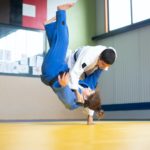Chinese Martial Arts
Throughout the world, Chinese martial arts are well-known and well-respected. China is a pioneer in martial arts, founding several excellent styles. Although Kung Fu is the most well-known Chinese martial art, there are others that are just as good. Below, we will look at some of the other Chinese martial arts that aren’t as well known as Kung Fu.
HSING-I
This is actually one of the internal styles of Kung Fu, very closely in relation to Tai Chi. It teaches students to subordinate their bodies, creating powerful movements with very little expenditure of energy. HSING-I isn’t well known, although it is very powerful and well-known throughout China. The United States and other areas aren’t that familiar with it, with little to no schools or dojo’s out there that teach it.
Just like Tai Chi, HSING-I has deep roots in Chinese medicine and the Chinese perceptions of nature. The blows that come from HSING-I come from the five elements of the Chinese – metal, fire, earth, water, and wood. Similar to other forms that originate from Kung Fu, HSING-I offers complex, dance-like movements that are adapted from the way animals react and move. Due to the training being so demanding and rigorous, and the breathing exercises being so demanding, those who practice this martial art have astounding physical skills and amazing endurance.
Tai Chi
To those who live outside of China, Tai Chi resembles more of a dance. The slow and calm movements it teaches are balanced and exact, performed while the stylist is in a deep state of relaxation. While in this deep state of relaxation, the stylist will be fully aware of what he is doing and his movements, although he will appear to those around him to be asleep.
In reality, Tai Chi is an energy exercise that promotes strength, stamina, and flexibility. By using the deep state of relaxation, Tai Chi enables stylists to benefit emotionally and spiritually as well. Tai Chi also uses deep states of meditation as well, helping stylists to learn how to reach a high level of peace.
Chinese Martial Arts
Even though Kung Fu is the best martial art in China, there are many different forms and styles that originate from it. There is the Shaolin style as well, which offers several different styles of Kung Fu as well, including the world-famous “5 animals system”. The five animals system is among the most popular in China and well-known around the world for its devastating techniques and amazing power when used in combat.
Along with Kung Fu, both HSING-I and Tai Chi are great martial arts that help with endurance training and flexibility. A lot of Kung Fu students in China choose to study one of these arts as well, as it helps to add to their physical and emotional power. Students who study Tai Chi or HSING-I as well as Kung Fu, have a higher state of endurance and spirituality that simply cannot be matched.
All around the world, China is well known for martial arts. China brought Kung Fu and Tai Chi to the world, which is something we are all thankful for. Even though Japan offers its unique blend of martial arts, many consider China to be the founding father of martial arts. The Chinese have been using martial arts for hundreds of years – providing just how dominant it can be as a means of self-defense and a way to live your life in a peaceful manner.
DISCLAIMER:
This information is not presented by a medical practitioner and is for educational and informational purposes only. The content is not intended to be a substitute for professional medical advice, diagnosis, or treatment. Always seek the advice of your physician or other qualified healthcare providers with any questions you may have regarding a medical condition. Never disregard professional medical advice or delay in seeking it because of something you have read.
Since natural and/or dietary supplements are not FDA-approved they must be accompanied by a two-part disclaimer on the product label: that the statement has not been evaluated by FDA and that the product is not intended to “diagnose, treat, cure or prevent any disease.”





